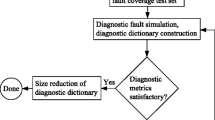Abstract
The paper proposes a hierarchical untestable stuck-at fault identification method for non-scan synchronous sequential circuits. The method is based on deriving, minimizing and solving test path constraints for modules embedded into Register-Transfer Level (RTL) designs. First, an RTL test pattern generator is applied in order to extract the set of all possible test path constraints for a module under test. Then, the constraints are minimized using an SMT solver Z3 and a logic minimization tool ESPRESSO. Finally, a constraint-driven deterministic test pattern generator is run providing hierarchical test generation and untestability proof in sequential circuits. We show by experiments that the method is capable of quickly proving a large number of untestable faults obtaining higher fault efficiency than achievable by a state-of-the-art commercial ATPG. As a side effect, our study shows that traditional bottom-up test generation based on symbolic test environment generation at RTL is too optimistic due to the fact that propagation constraints are ignored.









Similar content being viewed by others
References
Agrawal VD, Chakradhar ST (1995) Combinational ATPG theorems for identifying untestable faults in sequential circuits. IEEE Trans Comput Aided Des 14(9):1155–1160
Brayton RK, Hachtel GD, McMullen CT, Sangiovanni-Vincentelli AL (1984) Logic Minimization Algorithms for VLSI Synthesis. Kluwer Academic Publishers, Boston
Chayakul V, Gajski DD, Ramachandran L (1993) High-Level Transformations for Minimizing Syntactic Variances, DAC (Proceedings of the Design Automation Conference), Dallas, Texas, USA, p 413–418
De Moura L, Bjørner N (2008) Z3: An Efficient SMT Solver. TACAS (International Conference on Tools and Algorithms for the Construction and Analysis of Systems (TACAS)), Budapest, Hungary, p 337–340
Dillig I, Dillig T, Aiken A (2010) Small Formulas for Large Programs, Proc. of the 17th intl. conf. on Static Analysis, Springer-Verlag, Berlin, Heidelberg, p 236–252
Fujiwara H, Ooi CY, Shimizu Y (2008) Enhancement of Test Environment Generation for Assignment Decision Diagrams, 9th IEEE Workshop on RTL and High Level Testing, Nov. IEEE, Sapporo, Japan, 45–50
Ghosh I, Fujita M (2000) Automatic test pattern generation for functional RTL circuits using assignment decision diagrams, Proc. DAC (Proceedings of the Design Automation Conference), Los Angeles, California, USA, p 43–48
HLSynth92 benchmarks. http://ftp.ics.uci.edu/pub/hlsynth/HLSynth92
ITC benchmarks. http://www.cerc.utexas.edu/itc99-benchmarks/bench.html
Iyer MA, Long DE, Abramovici M (1996) Identifying sequential redundancies without search. In: Proc. 33rd Annu. Conf. DAC, LasVegas, pp 457–462
Jervan G et al (2002) High-Level and Hierarchical Test Sequence Generation. IEEE HLDVT, Cannes, 169–174
Lee J, Patel JH (1994 Oct) Architectural level test generation for microprocessors, IEEE Trans. CAD (IEEE Transactions on CAD of Integrated Circuits and Systems), Piscataway, New Jersey, USA, p 1288–1300
Liang H-C, Lee CL, Chen EJ (1995) Identifying untestable faults in sequential circuits. IEEE Des Test Comput 12(3):14–23
Long DE, Iyer MA, Abramovici M (2000) FILL and FUNI: Algorithms to identify illegal states and sequentially untestable faults. ACM Trans Des Autom Electron Syst 5(3):631–657
Murray BT, Hayes JP (1988) Hierarchical test generation using precomputed tests for modules, Proc. ITC (Proceedings of the International Test Conference), Washington, D.C., USA, p 221–229
Peng Q, Abramovici M, Savir J (2000) MUST: multiple stem analysis for identifying sequential untestable faults. In: Proc. Int. Test Conf. IEEE, Atlantic City, NJ, USA, p 839–846
Raik J, Fujiwara H, Ubar R, Krivenko A (2008) Untestable fault identification in sequential circuits using model-checking. ATS (Proceedings of the Asian Test Symposium), Sapporo, Japan, p 667–672
Raik J, Rannaste A, Jenihhin M, Viilukas T, Ubar R, Fujiwara H (2011) Constraint-Based Hierarchical Untestability Identification for Synchronous Sequential Circuits, Proc. of the European Test Symposium, IEEE Computer Society, Trondheim, Norway, p 147–152
Raik J, Ubar R (1999) Sequential Circuit Test Generation Using Decision Diagram Models, Proceedings of the DATE Conference, IEEE Computer Society, Munich, Germany, p 736–740
The ECLiPSe Constraint Programming System http://eclipseclp.org/
Vedula V, Abraham J (2002) FACTOR: A Hierarchical Methodology for Functional Test Generation and Testability Analysis, DATE Conf., IEEE Computer Society, Paris, France, p 730–734
Viilukas T, Raik J, Jenihhin M, Ubar R, Krivenko A (2010) Constraint-based test pattern generation at the register-transfer level, 13th IEEE DDECS Symposium, IEEE Computer Society, Vienna, Austria, p 352–357
Zhang L, Ghosh I, Hsiao M (2003) Efficient Sequential ATPG for Functional RTL Circuits, Int. Test Conf., IEEE, Charlotte, NC, USA, p 290–298
Acknowledgments
The work has been supported by European Commission Framework Program 7 project FP7-ICT-2009-4-248613 DIAMOND, by Research Centre CEBE funded by European Union through the European Structural Funds and by Estonian Science Foundation grants 9429 and 8478.
Author information
Authors and Affiliations
Corresponding author
Additional information
Responsible Editor: C. Metra
Rights and permissions
About this article
Cite this article
Viilukas, T., Karputkin, A., Raik, J. et al. Identifying Untestable Faults in Sequential Circuits Using Test Path Constraints. J Electron Test 28, 511–521 (2012). https://doi.org/10.1007/s10836-012-5312-5
Received:
Accepted:
Published:
Issue Date:
DOI: https://doi.org/10.1007/s10836-012-5312-5




